Collected and posted by Oconto County WIGenWeb Project
Collected and posted by BILL
This site is exclusively for the free access of individual researchers.
* No profit may be made by any person, business or organization through publication, reproduction, presentation or links
to this site
Written by Marie Darrow
Compositor - Ben Penkivich, for the Gillett Public Library
Scanned and contributed by Jennifer Bumann
Family Site Researching Oconto County surnames
JOHN, DEADRICH, CAIN and ROSA
EARLY SETTLERS
Before the time of the Revolution the land where Gillett was destined to be built had been claimed by a Spanish Queen and by French and English Kings.
After the Revolution, and before a strong central government had been established, this area was claimed by Massachusets, Connecticut, New York and Virginia. By 1785 the states gave up their claims and the United States designated the area north of the Ohio River and east of the Mississippi as the Great Northwest Territory. States were to be formed from this territory and admitted to the Union on equal standing with the original states as certain requirements were fulfilled. Until that time this area was governed by a legislature that met in Cincinnati. Wisconsin was the last of the five states formed from this territory to be admitted to the Union. When Wisconsin became a state in 1848 there were still only Indians in the Gillett area. Six years later when Henry Tourtllotte came here with his Indian wife, this area was part of the large township of Stiles.
In 1854, the first white settler came to the area now known as Glllett; Henry Tourtilotte, bringing his Indian wife and four children with him, built a split-level log house on a slope across from the present grade school, now the site of a brick home on the corner of 1st and Main. Court House records show that the land still belonged to the United States Government at that time and there Is no official record of any Tourtllotte ownership.
A year later Henry Clark and his Indian wife and their three children moved into the local area. Both Tourtilotte and Clark hunted, trapped, and traded with the Pottowatomi Indians. The Potowatomi settlement was northwest of the present town of Gillett, and even today arrowheads are turned up by farmers plowing in that vicinity. Middle-aged residents may remember the old Potto-watomi cemetary with its covered graves.
Rodney Gillett for whom the community was named,
was born in Albany, New York In 1833. His parents moved to
Pennsylvania,
they to Illinois, and later to Minnesota. Rodney did not go to
Minnesota
with them, but chose to go to northern Wisconsin where he worked at
Shawano
and Oconto. He liked the area halfway between Shawano and Oconto; and
after
his marriage in 1858 to Mary Roblee of Clayton, Wisconsin, he came here
with his wife to make his home. He owned a yoke of oxen, a cow, and a
few
pieces of furniture. He evidently liked Mr. Tourtilottes's homestead
for
he bought it in 1859. Mrs. Gillett was the first white woman to settle
in Gillett Center as it was then called. Mr. Gillett hired Clark and
Tourtilotte
and some Indians to help him cut logs and haul them back to the river.
The old tram road, a courduroy road, crossed the Bill Lambreacht farm
to
Flat Rock. In the spring when the river was high, the logs were floated
to Oconto to a sawmill where there was a ready market for timber.
(page 6)
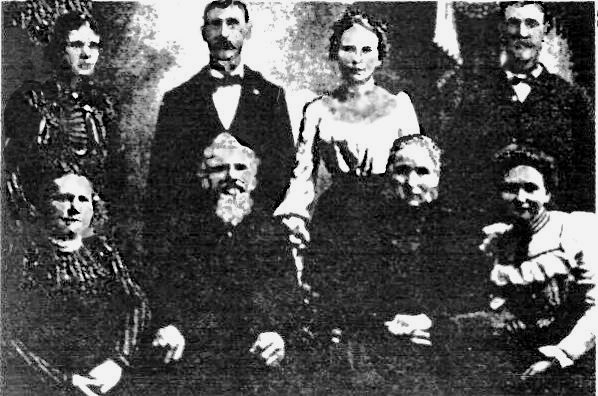
GILLETT FAMILY
There was no road to Oconto at this time and so all supplies had to be carried over the Indian trails. But as soon as he was able, Rodney Gillett purchased a team of horses, the first to be driven In this area. Mrs. Ed Kosbob remembers stories told about her grandfather walking to Oconto for flour. Her grandmother would take an empty sack and meet him somewhere along the trail on his return trip where they divided the load and trudged on home together.
Court House records show the downtown area of Gillett belonging to Mr. Chauncey Baker in 1856; and later in the same year to a Mr. R. A. Jones; then back to Mr. Baker. In 1857 it was sold to Mr. Edward Ramsey. In February of 1858, Rodney Glllett and Otis Flanders leased the land for a term of three years, They were to pay for the land lease by clearing 40 acres, enclosing It with a rail fence 7 rails high, and leaving 4 1/2 tons of English hay on the premises at the expiration of their lease. In October, Mr. Gillett purchased an intrest in this property and other properties from Mr. Ramsey for $600. In 1960 Edward Ramsey sold his undivided half interest in the land to Mr. and Mrs. Gillett who held the land all during the period of the Civil War.
At this time a large cedar yard owned by Louis Runkel,
stacked high with cedar posts, extended from the tamarack swamp area
(north
of Richmond St.) to Lake Street and all the way from the backs of the
Main
St. Buildings to the lakes. First St. was passable from the cedar yard
and on it was a fine brick home now on the corner of First and Main. It
was occupied by the family of Rodney Gillett's son-in-law, Robert
Miniely,
who was the depot agent. Across the road from the Miniely home was a
large
fenced-in deer reserve belonging
(page 7) to Rodney
Gillett. Here he kept
deer captured in the summer for winter meat for his family and for sale
to others. The fenced-in area extended from the Dr. Driscoll residence
East to Include the Mike Melchlor residence and then south to Savage
Lake
(then called Gillett Lake) and beyond it up the hill to Fourth Street.
Mr. Gillett's property extended North from the deer reserve and home
and
included all the present city north of the tracks and West of McKenzie
St.
The George Newton family moved into the area in the summer of 1859. Newton's Lake was named for them. At this time there was a small creek East of town and Mrs. Newton hung her wash on the bushes near the creek. The river drivers named It Calico Creek. Mrs. Newton, known as Grandma Newton, was community nurse, doctor, and newspaper as she went from house to house, wherever she was needed, distribu-ting her herbs and homemade remedies, carrying the news and knitting as she walked. There was no doctor nearer than Oconto. Old timers say that she was reported to have once walked from here to the state of Washington.
The William John family moved from Oconto to the area near Whitings Cheese Factory on the corner of Spring Hill Rd. and Highway G, in the year of 1857. His home was a stopping place for many a weary traveler. He was a genial host. His wife prepared tasty meals which were served with punctuality. In 1875 they opened a type of hotel.
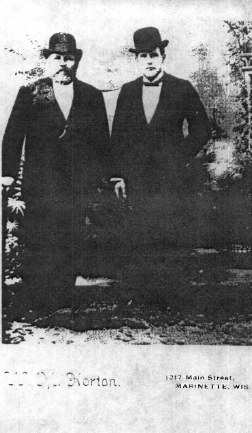 F. W. John
& son Vic
F. W. John
& son VicMrs. John was left alone with the children when her husband went to fight for the Union in the Civil War. She was forced to provide for them in the wilderness and became an expert rlflewoman, bagging wild game for food. Later after Mr. John's return from war, they moved onto land that became a part of the city of Gillett.
Joseph Helmke and Charles McKenzier settled in Gillett before the/ left for servide In 1962. Mr. Helmke buried his tool chest before leaving and found It in good condition when he returned.
Matt Finnegan came in 1864. Harriet Gale came in 1869. The Dan McDonnell family moved here from Canada in 1874. The Howell family moved in west of Gillett, but lived within the present city limits in the late 1870's.
And so the area became settled. The growth and prosperity of any community depends greatly upon the surrounding countryside and on the character, Industry, and ingenuity of its inhabitants. In this Gillett was fortunate. Many Scandinavians came to work on the Pulcifer dam and stayed to make homesteads - many settling in the area south of Gillett: Gilbertson, Peterson, Engebretson, etc. About 1876, an Irish settlement and Scotch-Irish, and German was started in the northeast: Gradys, McDonnells, Murphys, and Johnsons; Begolkes, Neumanns, Winklers, Zahns, and Schmldts.
In 1883, William and Ernestine Kasten arrived from
Germany with their five children - Henry, Herman, August, Bertha, and
Augusta.
He became a successful farmer, built the home on Kasten Lake occupied
at
this writing by Attorney Leon Rlemer and his family. He also became the
owner of much property along the southern edge of the city.
The years following the Civil War were hard years in this area
evidenced
by the fact that Mr. Gillett was forced to mortgage his property and
even
then was unable to pay his taxes. Two years later Rodney Gillett
purchased
his land for $10. This was for 20 acres comprising today the entire
downtown
area of Gillett. In 1884 Mr. Gillett and Uri Balcom hired Mr. A.
Elgleston
to survey and map the land south of the railroad tracks and to
designate
the boundaries of the Village of Gillett. This map is on file at the
Court
House in Oconto in Vol 41 of Deeds, page 467. Mr. Gillett began
immediately
to sell lots along the present Main Street in Gillett.
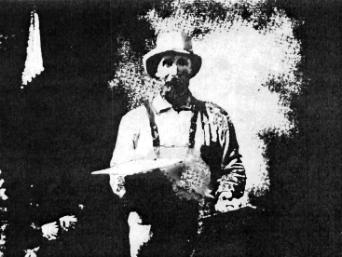 Torkel
Engebretson
Torkel
Engebretson
1842-1911
Father of Sam & Julius
& Emdla
Grandfother of Melvin &
Edward
The picture was taken while
he was plastering at the Nygard
Studio about 1900 in the house
East of the High School.
(page 9)
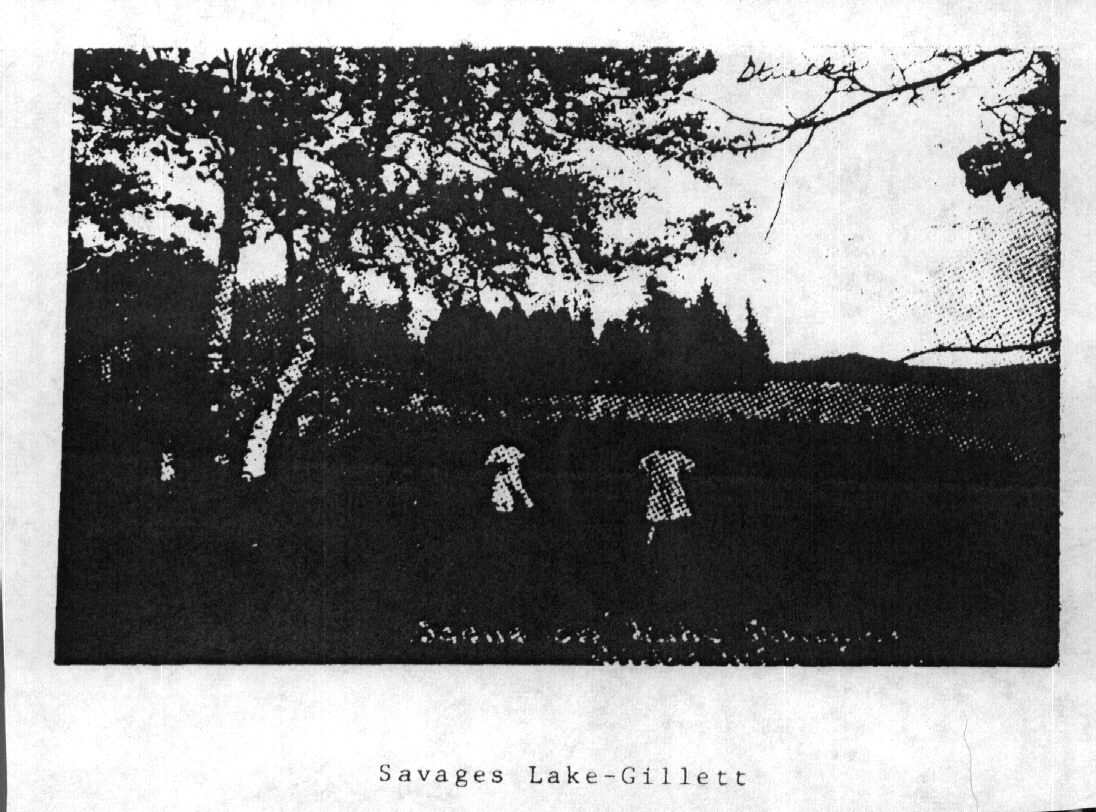
Savages Lake - Gillett
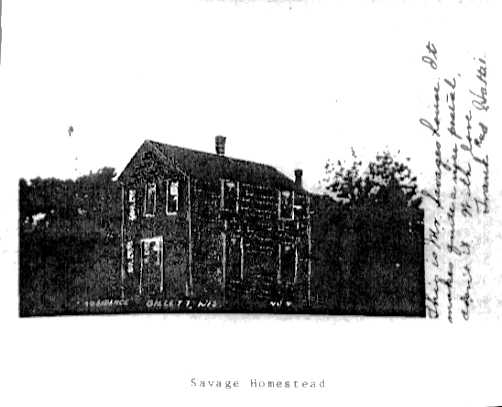
Savages Gillett, WI
Postcard
Note on right side:
"This is Mrs. Savages
house. It
makes quite a nice
postal
don't
it. With Love,
Frank and Hattie"